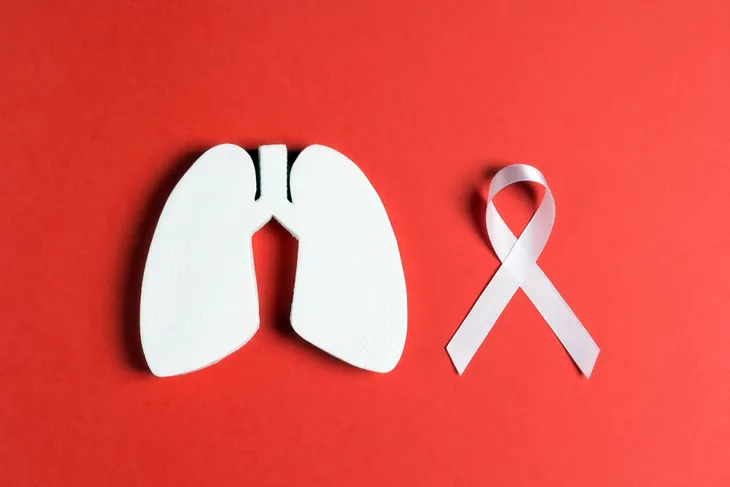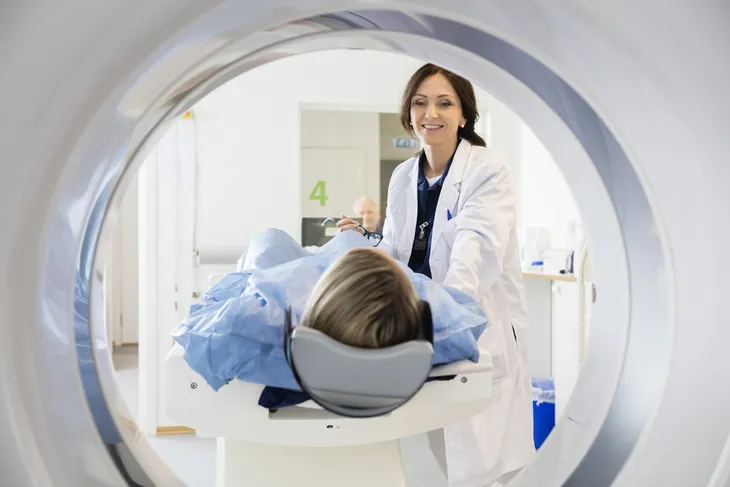- Lung cancer is the third most common cancer in the United States.
- While there are some early signs to watch for, it often goes undetected until the disease has advanced and spread.
- Protect your health by getting informed and talk to your doctor about your risk for lung cancer.
Lung cancer is an awful disease that develops when cells divide and mutate uncontrollably. Over time, cancer prevents your lungs from working properly, resulting in unpleasant symptoms. It’s a lot more common than you may think too.
According to the National Cancer Institute, lung cancer is the third most common cancer in the United States. It’s estimated that there are over 200,000 new cases each year. Unfortunately, it often goes undiagnosed until it’s in an advanced stage. But cancer screenings offer hope in detecting cancer early. One way you can protect your health is by getting informed. Here’s a look at everything you need to know about lung cancer.
Early Warning Signs of Lung Cancer
Unfortunately, the American Cancer Society says most lung cancers don’t cause any symptoms until the disease has spread. But there are still early warning signs you should be on the lookout for that could indicate lung cancer.
For starters, the Cleveland Clinic says a persistent cough or pneumonia that keeps coming back after treatment can be an early warning sign of lung cancer. Other warning signs include:
- A cough that doesn’t go away
- A cough that gets worse
- Shortness of breath
- Chest pain
- Hoarseness
- Loss of appetite
- Unexplained weight loss
- Fatigue and weakness
- New onset wheezing
Many of these symptoms can indicate something far less serious, but it’s always important to have any new or persistent symptoms checked by a doctor.
Advanced Symptoms of Lung Cancer
If lung cancer goes undetected it can spread to other parts of the body. This can cause more advanced symptoms. The American Cancer Society says to watch for the following signs that cancer has spread to other areas of the body:
- Bone pain
- Yellowing of the skin and eyes (jaundice), which occurs if cancer spreads to the liver
- Swelling of the lymph nodes
- Nervous system changes if cancer spreads to the brain. This can be presented as headaches, dizziness, weakness, balance problems, and seizures.
Types of Lung Cancer
The Cleveland Clinic explains that many different types of cancers can affect the lungs, however, when people refer to lung cancer, they’re usually referring to two main kinds, including non-small cell lung cancer and small cell lung cancer.
The source says that non-small cell lung cancer is the most common type and accounts for 80-percent of all lung cancer cases. The most common types of non-small cell lung cancer include squamous cell carcinoma and adenocarcinoma.
Small cell lung cancer, on the other hand, tends to grow more rapidly and is harder to treat. The source explains that it’s often found as a small tumor that has already spread to other areas of the body. Types of small cell lung cancer include small cell carcinoma and combine small cell carcinoma.
Other Types of Cancer in the Lungs
Other types of cancers can develop in or around the lungs too, including:
- Lymphomas (cancer of the lymph nodes)
- Sarcomas (cancer of the bones or soft tissue)
- Pleural mesothelioma (cancer in the lining of the lungs)
The Cleveland Clinic notes that these types of cancer aren’t usually referred to as lung cancer. They’re also typically treated differently than non-small cell lung cancer and small cell lung cancer.
What Causes Lung Cancer?
It should come as no surprise that smoking is the leading cause of lung cancer. In fact, the American Cancer Society says 80-percent of lung cancer fatalities are caused by smoking. And unfortunately, the source also notes that many other cases are caused by exposure to secondhand smoke.
Though smoking is the leading cause, not everyone who smokes develops lung cancer. Many other factors such as genetics could play a role. Let’s take a look at other possible causes next.
What Causes Lung Cancer in People Who Don’t Smoke
According to the Cleveland Clinic, up to 20-percent of people with lung cancer have never smoked. So, if this is the case, what causes lung cancer in people who don’t smoke?
The American Cancer Society says other causes include secondhand smoke, exposure to radon (a naturally occurring radioactive gas), and air pollution. Exposure to harsh chemicals, diesel exhaust, and asbestos in the workplace can also lead to lung cancer for some people. The source also notes that in a few cases, lung cancer develops with no known risk factors. While it may be due to random events, the source says it could also be caused by factors that haven’t been discovered yet.
How Is Lung Cancer Diagnosed?
If you’re showing signs of lung cancer or are at risk, you should contact your doctor right away. Diagnosing lung cancer typically starts with a physical exam, reviewing your medical history, and your current symptoms. During the physical exam, your doctor will listen to your heart and lungs.
If lung cancer is suspected diagnostic testing will be required to confirm a diagnosis. According to the Cleveland Clinic, your doctor may request blood tests or a chest X-ray. Further imaging tests are also often needed to confirm a diagnosis, such as a computed tomography (CT) scan. A lung biopsy may also be needed.
Lung Cancer Staging
Once lung cancer has been confirmed, the next step is determining what stage of cancer you have. The Cleveland Clinic says “Cancer is usually staged based on the size of the initial tumor, how far or deep into the surrounding tissue it goes, and whether it’s spread to lymph nodes or other organs.”
The following is the general staging for lung cancer:
- Stage 0: Cancer is in the top lining of the lung (or bronchus) but hasn’t spread to other parts of the body.
- Stage I: Cancer hasn’t spread outside of the lung.
- Stage II: Cancer is bigger than Stage I and has spread to lymph nodes inside the lung or there is more than one tumor in the same lung.
- Stage III: Cancer is larger than Stage II and has spread to nearby lymph nodes or structures or there is more than one tumor in the same lung.
- Stage IV: Cancer has spread to the other lung, the fluid around the lung or the heart, as well as other organs in your body.
How Is Lung Cancer Treated?
After receiving a lung cancer diagnosis, your medical team will work together to develop a treatment plan for you. Treatment will vary depending on what type of cancer you have, where it’s located, the staging, as well as other factors. That said, the ultimate goal of treatment is to slow down the growth and hopefully get rid of cancer in your body.
The following are possible treatment strategies for lung cancer:
- Surgery
- Radiofrequency ablation
- Radiation therapy
- Chemotherapy
- Targeted drug therapy
- Immunotherapy
What Is the Outlook?
Receiving any cancer diagnosis can be stressful and overwhelming and wondering about the prognosis is a common thought for cancer patients. The Cleveland Clinic explains that how fast cancer spreads depends on the type, and unfortunately, lung cancer is often found after it’s already spread to other areas in the body. That said, some types of lung cancer can be “considered cured” if it’s diagnosed before it spreads. Doctors don’t typically use the term “cured”, but instead may say things like “remission” or “no evidence of disease.”
The source says if you’re in remission or have no evidence of disease for 5-years or more, you may be considered cured. However, there is always a chance cancer can return, which is why follow-up screening is so important.
What Is the Survival Rate of Lung Cancer?
First, it’s important to note that the survival rate depends significantly on when the cancer was diagnosed, how far it has spread, how it responds to your treatment, as well as your overall health and many other factors. The Cleveland Clinic emphasizes that survival statistics don’t account for the specific details of your diagnosis and treatment. It’s important to discuss this with your doctor.
The good news is, lung cancer casualties have been rapidly decreasing in recent years. For starters, the source says small tumors that haven’t spread to the lymph nodes have a survival rate of 90-percent for tumors that are smaller than 1-centimeters (cm), 85-percent for tumors that are 1- to 2-cm, and 80-percent for tumors that are between 2- to 3-cm. The source also notes that the relative 5-year survival rate for lung cancer diagnosed at any stage is 22.9-percent but this can vary greatly depending on a variety of factors.
Can Lung Cancer Be Prevented?
While lung cancer can’t always be prevented, there are things you can do to reduce your risk. For starters, if you smoke, it’s really time to quit and if you don’t smoke, don’t start! Quitting smoking is not easy, so reach out to your doctor for support. The Cleveland Clinic also notes, “Your risk of lung cancer starts coming down within five years of quitting.”
Other ways you can reduce your risk for lung cancer is by avoiding secondhand smoke as well as other substances that can be harmful to your lungs. Eating a healthy balanced diet and maintaining a healthy weight for you is also important for reducing your risk of cancer. Finally, if you have a high risk of lung cancer, you should be screened.
What to Know About Lung Cancer Screening
While lung cancer doesn’t often show signs until the cancer advances, screening may be able to help detect cancer when people aren’t showing symptoms. Johns Hopkins Medicine explains that cancer screening is a test that “offers hope for early detection, when surgery is a potential cure.” It’s typically recommended for people who have a high risk of lung cancer.
The source says, historically, chest X-rays are used to look for signs of lung cancer, however, they offer less detailed images compared to advanced technology like a CT scan. The source notes that a low-dose helical CT scan is another screening tool that can take “multiple 3-dimensional pictures of the chest moving in a spiral motion around the body.” Another benefit is that it produces five times less radiation compared to a traditional CT scan.
Who Should be Screened for Lung Cancer?
People who have a high risk of developing lung cancer should be screened. Johns Hopkins Medicine says the following are criteria for high-risk individuals:
- A history of heavy smoking (at least a pack per day for 30-years).
- Current or former smokers who quit within the past 15-years.
- Are between the ages of 55 to 80.
If you’re worried about your risk of lung cancer, contact your doctor. They can help determine if you’re at risk, whether you should be screened, and help you develop healthy habits to reduce your risk.

















